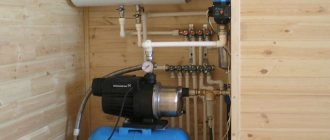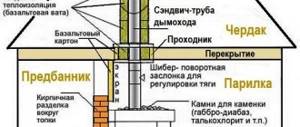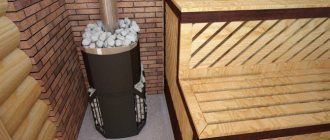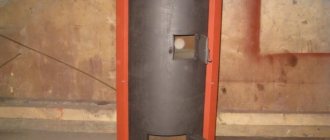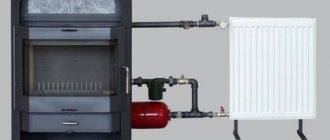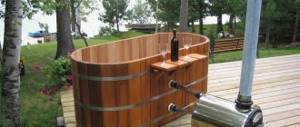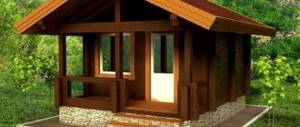Material for making a font
The most common material for making a font is wood or plastic, or rather polypropylene. Bathtubs made of wood look aesthetically presentable, but these types of bathtubs have one significant drawback: the wood shrinks when it dries.
To give an analogy for comparison, a wooden font, like a barrel, must be constantly in a humid environment in order to avoid shrinkage of the wood and the natural appearance of cracks in the sides of the product. So, recently, bath fonts made from blue polypropylene have become increasingly popular. Thanks to the modern properties of the plastic used, polypropylene hot tubs do not require much attention to operate. In everyday care they are no different from enamel bathtubs; it’s also easy enough to wash with a cleaning agent and that’s it.
Phytospring
“Fytorodnik” is a Russian manufacturer of wooden products for baths and saunas. The company was founded in 2002, and today its staff is more than 100 people. Production is located in Novosibirsk. In addition to swimming pools, they produce cedar barrels, prefabricated wooden saunas, products for baths, SPA and saunas, houses and cottages. The main raw materials for making hot tubs: larch, cedar, oak.
Product features and range
Wooden bathtubs
.
Traditional version. The wood used in production is larch, cedar or oak. Options: podiums, possibility of delivery in disassembled form, thermal cover, cover. This option is suitable for lovers of a real Russian bath. Characteristics of wooden hot tubs from “Fitorodnik”
| Material | Larch | Altai cedar | Oak |
| Form | Oval, round, corner, double round, double oval. | ||
| Dimensions, H×L×W or H×D, cm | (100…120)×(106…183)×(59…131)(100…120)×(117…180) It is possible to manufacture according to dimensions specified by the customer. | ||
| Wall thickness, mm | 28±5 | 35±5 | 25±5 |
| Attaching the hoops | Screw connection | ||
| Coating | Wax inside and out | ||
| Equipment | Wooden ladder and seat, drain/overflow, key for adjusting the hoops, passport. Additionally: “porch” or regular podium, supplied disassembled, thermal cover, cover. | ||
| Estimated cost | From 31900 rub. for a product measuring 100×106×59 (H×D×W) cm up to 215900 rub. for a double round model 120×150 (H×D) cm. | From 32900 rub. for a product measuring 100×106×59 (H×D×W) cm up to 183900 rub. for a double round model 120×150 (H×D) cm. | From 44900 rub. for a product measuring 100×106×59 (H×D×W) cm up to 293900 rub. for a double round model 120×150 (H×D) cm. |
Containers with wooden trim and insert made of polymer material
.
The manufacturer offers options, including electric heating, hydro and air massage, mixer, lighting, etc. This option will appeal to connoisseurs of comfort and SPA treatments. Characteristics of hot tubs with plastic inserts from “Fitorodnik”
| Insert | Composite | Polypropylene |
| Finishing | Pine, oak. | Altai cedar, larch, thermo-ash, oak. |
| Form | Oval, round, angular. | Oval, round, angular and their double models. |
| Dimensions, H×L×W or H×D, cm | 110×(125…175)×(79…98)110×195 | 128×(120…170)×(80…150)128×(120…200) |
| Wall thickness, mm | 25±5 | mostly 25±5, but there are options 35±5 |
| Attaching the hoops | Screw connection | |
| Coating | Water-repellent composition on the outside. | Varnish on the outside. |
| Equipment | Drain and overflow, wooden seat and ladder, passport. Free staining upon request. Additionally: thermal cover, cover, insulation. | Drain-overflow, passport.Additionally: electric heating, stainless steel ladder, hydro and air massage, mixer, lighting, wooden ladder and seat, plastic seats. |
| Estimated cost | From 63900 rub. for an oval font 110×125×79 cm with pine trim up to 131900 rub. for the model 110×160×160 cm with oak trim. | From 97900 rub. for an oval font 128×120×80 cm with Altai cedar trim up to 619900 rub. for a double model 128x200 cm with thermo-ash trim. |
Get to know the production better - watch a 6-minute video about all the intricacies of the production of Fitorodnik products, from developing the design of the future product to finishing.
Conclusion:
If you are looking for a manufacturer with a wide range, then you should pay attention to Phytorodnik. Prices are average for the market. The company works in several directions at once, so in the catalog you can choose both a simple font for a cramped Russian bath and a multifunctional container for modern saunas.
How to fit a plastic font into the interior?
| The plastic font fits amazingly perfectly into any interior. Thanks to the strong body, it can be manufactured according to your individual dimensions with curves that match the interior of your sauna or relaxation room. Fonts made of polypropylene are easy to decorate. For decoration, valuable wood, tiles and marble tiles, mosaics and many other various decorative elements are often used. The bathhouse was and remains a very popular way to relax and cleanse your body of dirt and fatigue, and your head of sad thoughts. In addition, this is also a very useful procedure, especially if, in addition to sitting in the steam room for a long time, you use contrasting cold water and repeat such procedures several times. invites you to buy a plastic font, which will allow you to comfortably conduct such events. |
Product Description
is a large manufacturer of a wide variety of devices and containers made of polymer ethylene and propylene. A plastic bathtub made by us is not only a convenient and comfortable way to take water procedures. They have many advantages, including:
- ease of processing - you can use the most common detergents to clean them;
- ability to withstand high temperatures up to – 120 degrees;
- resistance to sudden changes in temperature;
- Absolutely environmentally friendly and safe for health;
- light weight, which makes their transportation and installation extremely simple;
- long service life, estimated in decades;
- low price.
In addition, unlike traditional wooden ones, plastic does not absorb water, does not swell, does not shrink, and will not begin to rot after prolonged use.
If you are interested in a high-quality and durable plastic bathtub, the price of which will be affordable for you, I am ready to help you with this.
Range:
In our company you can buy plastic hot tubs of any shape and size. Typical options include:
- rectangular;
- oval;
- round;
- square;
- corner.
As for the volume of containers, we can find options from 900 to 20,000 liters. The same applies to linear dimensions. But if you have any special preferences, then we are always ready to make containers for you according to your drawings.
In addition, our hot tubs can be equipped with a wide variety of equipment, including lighting, a water heating system and much more.
If you want to buy a cheap plastic hot tub, contact us in any way possible. Our experts will be able to advise you on any questions of interest and help you decide on the specific parameters of the product.
Installation of a plastic hot tub
Installation of a plastic hot tub
Installation of a font in a recessed way in a bathhouse
To work you will need:
- building level;
- shovel;
- gravel or small crushed stone;
- sand;
- cement M400 and higher;
- reinforcing bars with a diameter of 8-10 mm;
- wire five;
- Bulgarian;
- knitting wire;
- boards made of boards or sheets of plywood;
- strong timber;
- insulation (penoplex, polystyrene foam);
- waterproofing impregnation;
- black polyethylene film;
- plastic pipe with a diameter of 50 mm.
Step 1. Determine the location of the font and make markings for the pit.
Marking for the pit
The shape of the pit should match the shape of the plastic bowl, but be a little larger. The thickness of the concrete walls is 150-170 mm, plus the thickness of the insulation - from 20 to 50 mm. It turns out that the perimeter of the hole should be 20 cm larger on each side; if the bowl is round, the diameter of the pit is increased by 40 cm.
Pit for installing a font
Depth is calculated differently. As a rule, the font is not buried to its full height, leaving a side of up to 20 cm above the surface. The thickness of the concrete fill at the bottom together with the gravel-sand cushion is 20-25 cm, the thickness of the leveling screed is 6-8 cm. So, they add to the height of the bowl the thickness of the concrete layer, screed and insulation, then subtract the height of the side.
For example, the height of the container is 1.2 m, the side is left 10 cm, then the depth of the pit will be 1.43 m:
1.2 m + 20 cm + 8 cm + 5 cm – 10 cm = 1.43 m
Step 2. Dig a hole according to the calculations made. At the same stage, a sewer pipe should be laid. From the sewage pit, in a straight line, they dig a trench through the wall of the same depth as the pit, but with a slight slope towards the pit. A drain pipe is laid across the entire trench, the end of the pipe is brought out in the center of the pit if the bowl is round, or in one of the corners if the font is rectangular. Place a vertical bend on the pipe and seal the joints. To prevent foreign objects from getting into the pipe, a plastic plug is temporarily placed on top.
Laying the drain pipe
Step 3 . After leveling the surfaces, a layer of sand is poured onto the bottom, leveled, moistened and compacted so that the thickness of the sand cushion is 10 cm. The next layer is gravel. The drain pipe should protrude at least 10 cm above the surface; all excess will be cut off before installing the bowl.
In the photo there is a sand cushion
Step 4. Using a grinder, cut the reinforcement into pieces of the required length and form a lattice on the bottom and walls of the pit.
Scheme of laying reinforcement at the bottom of the pit bowl
The rods are tied with thin wire so that cells of 150x150 mm or slightly larger are obtained. The reinforcing layer is attached to the walls with brackets made of five-piece wire, but at the same time there should be 40x50 mm of free space between the grating and the ground. At the bottom, pieces of tiles, bricks or pipe cuttings are placed under the grate, raising it by the same 50 mm.
Installation of reinforcing grid
An example of a reinforcement frame for a font
Step 5. Install the formwork: sheets of plywood are lowered into the pit, fastened tightly together around the perimeter, spacers from the timber are inserted into the resulting box. There should be 7-10 cm between the formwork and the reinforcing layer. If the font bowl is round, installation of the formwork will be much more difficult and will take longer. For cup-shaped formwork, instead of plywood, PVC panels with a wall thickness of 5-6 mm are used, which are easily arched.
Formwork frame
The frame is covered with OSB sheets
Installed formwork
Poured formwork
Step 6. Prepare the solution: mix cement, sand and crushed stone in a ratio of 1:3:5, dilute with water so that the solution is thick enough, and pour it into the formwork. Fill everything at once, piercing the solution with a sharp rod along the entire perimeter to avoid the formation of voids. The top is smoothed, the formwork is covered with polyethylene so that the moisture does not evaporate too quickly. It takes at least 28 days for concrete to harden and harden.
Pouring formwork with concrete mortar
Step 7. After 10-15 days, the concrete walls are already strong enough, so the formwork can be dismantled. Do this as carefully as possible, trying not to damage the surface. The sagging and protrusions remaining after formwork are carefully cleaned off, and deep recesses are sealed with mortar. Further work is carried out after the surface has completely dried.
Step 8 . The walls of the pit are plastered, the floor is cleaned of lumps of mortar and other debris, and the horizontal level of the floor is checked. Now you need to make a leveling screed and form a pit around the outlet of the drain pipe. The hot tub should be installed on the most flat surface possible, without distortions or slopes, so before pouring the screed, mark the walls using a level. Mix the solution, distribute it along the bottom of the pit, and level the surface.
Step 9 . When the screed has dried, the bottom and walls are treated twice with waterproofing impregnation, applying it with a roller or wide brush. Instead of impregnation, bitumen mastic is also suitable, which is also applied in two layers. The pit is especially carefully waterproofed, and the protruding end of the pipe is cut off flush with the surface.
Step 10 . After the surface has dried, lay the insulation in one layer and cover it with black plastic film on top. If the pit is bowl-shaped, it is recommended to cut the polystyrene foam sheets into strips - this makes it easier to bend and lay the material.
Step 11. Cut a hole in the bowl for the drain, then carefully insert the container into the hole and level it so that the drain hole is exactly above the pit. The edges of the font should also fit snugly against the walls around the entire perimeter. Next, coat the edges of the hole with sealant and install a stainless steel drain.
Installed font
Now all that remains is to finish the sides and supply water to the bowl. The sides can be covered with rubber paint, laid out with decorative tiles, or covered with panels made of wood or the same plastic. There are many options, so the choice is up to the bathhouse owner. As for filling the font with water: if the bowl is located against the wall, it is most practical to mount a mixer above the font. It should be at a height of 10-15 cm from the edge of the side. If the font is in the middle of the room, it will be easier to connect a hose to the mixer and fill the bowl through it. A small font can also be filled manually using buckets.
Prices for concrete mortar
concrete mortar
Recessed installation outdoors
To work you will need:
- roulette;
- pegs and rope;
- shovel;
- level;
- timber slats;
- tamping;
- sand.
The example font consists of two cubic parts; the lower one measures 110x190 cm, and the upper one measures 170x250 cm. The connecting line of these parts forms a wide and convenient ledge that can be used as a step.
Marking and preparing the pit
Step 1 . Determine a place to install the container, use pegs and rope to mark the perimeter of the pit, add 30 cm on each side and start digging. The shape of the pit should correspond to the shape of the font, so the pit will narrow downwards. The height of the container is 170 cm, the height of the side above the ground is 20 cm, the thickness of the sand cushion is at least 10 cm.
Calculate the depth of the hole:
170 cm – 20 cm +10 cm = 160 cm
Step 2. When the hole is ready, the walls are trimmed with a shovel and the bottom begins to be leveled with sand. For convenience, it is recommended to use two pieces of timber with a cross-section of 100x50 mm, laid on edge. The beams are placed at the bottom of the pit, 20 cm away from the walls, and sand is poured into the pit. It is advisable to moisten the sand well with water to compact it as tightly as possible. After tamping, you should check the horizontalness of the bottom with a level over the entire surface, because even small unevenness can cause distortions in the bowl. To stretch the beams, place a wide, dense board between them on the sand, and standing on it, carefully remove the guides. The grooves from the timber are also filled with wet sand and leveled.
Ready pit for a square font
Step 3. Install a plastic font in the pit. This should be done very carefully, trying not to catch the walls. Shedding of soil at this stage is extremely undesirable. You need to lower the container in the center so that there is an equal gap on all sides between the walls of the pit and the bowl.
Installation of a font in a pit
Step 4. All that remains is to fill the voids with sand and compact them. Under the weight of sand, the walls of the font can bend inward, so the addition should be done simultaneously with filling the container with water. The water level must be kept 10-15 cm above the sand level; First, use a hose to pour in a little water, then add and compact sand, pour water again, and so on until the very top of the font. It is most convenient to tamp with a piece of wooden slats or timber.
Step 5. Finally, the soil around the font is leveled and compacted. You can decorate the perimeter with stone, porcelain stoneware, paving slabs.
Frame installation
Frame installation
Installing an open hot tub is much simpler and does not require labor-intensive surface preparation. The most important thing is that the surface under the font is as smooth as possible.
To work you will need:
- bars 50x50 mm;
- hacksaw;
- sarking;
- water-repellent impregnation;
- self-tapping screws;
- screwdriver
If water from the font will be discharged through a drain, the container must be installed on a podium so that there is enough space between the bottom of the bowl and the floor for a siphon. The podium can be mounted from 50x100 mm timber and sheathed with boards 30 mm thick. Before installing the font, a hole for drainage is cut out in it and the same hole is made in the horizontal lining of the podium. Raise the container onto the podium, align the holes, connect the siphon and hose. After this, the plastic font can be covered with a frame.
Font frame
The timber frame should follow the shape of the plastic container. To do this, measure the width and length of the font and cut the timber into pieces of appropriate sizes. The parts are connected using self-tapping screws and metal corners or plates. Next, screw the vertical posts with self-tapping screws, the length of which is equal to the height of the font, and then mount the upper perimeter. To form a round frame, the ends of the timber are cut at an angle. The finished frame is sheathed with decorative panels or clapboard.
If you plan to drain the water using a pump, the font is installed directly on the floor. It is very important that the floor is absolutely flat and durable, because the load from water and the weight of people will be quite large.
Prices for a plastic font for a bath
plastic bath tub
Bath font
In Russian history, from time immemorial, the tradition of washing in a bathhouse has been widespread, and one of the main features of the Russian bathhouse is a sharp, shock drop in body temperature to increase blood flow in the body and improve well-being. But how to achieve a sharp temperature change when there is no ice hole nearby? Of course, you can use a cold shower, but under it the body cools down gradually. And only a dip in an ice bath can provide you with a sharp shock drop after going to the steam room in the baths. Nowadays, a bathhouse is considered an integral part of a good rest. Various types of fonts are being developed for the bathhouse, which can also be used as pools for a more relaxing recovery of the body.
Our production company creates bathhouses from standard sizes to bathtubs based on private, individually prepared projects.
BentWood
Russian furniture company BentWood has been on the market since 1998. Production is located in the Moscow region in Elektrougli. Specialization: furniture for baths and saunas, as well as accessories for them.
Product features and range
BentWood hot tubs are made using modern technology from oak and larch wood. In this case, sawn tongue-and-groove rivets are used: they are glued together, tightened with steel hoops and coated with a protective polymer composition.
You will learn the main advantages of the technology used for the production of oak bathtubs from a one-minute advertising video.
Characteristics of BentWood hot tubs
| Form | Round | Oval | Corner |
| Material | Oak, cedar, larch | ||
| Dimensions, H×L×W or H×D, cm | (117…180)×(100…140) | (100…140)×(106…183)×(59…115) | (100…140)×(110…153)×(110…153) |
| Wall thickness, cm | 2.5…2.8 for products made of oak and larch; 3.4…3.6 for cedar models | ||
| Attaching the hoops | Screw connection | ||
| Coating | Polyurethane | ||
| Equipment | Two-stage ladder, seats, internal drain-overflow, key for adjusting hoop tension, passport. Additionally: wooden handrail, external stove, external overflow. | ||
| Estimated cost | From 39,000 rub. for a model 100×117 (H×L) cm made of cedar up to 198,000 rubles. for an oak font 140×180 cm. | From 27,000 rub. for a cedar product 100×106×59 (H×D×W) cm up to 178,500 rubles. for the oak model 140×183×115 cm. | From 38,000 rub. for a cedar font 100×110×110 (H×W×D) cm up to 156,500 rub. for the oak model 140×153×153 cm. |
The manufacturer has 7 models of containers made from spliced parts. They will cost about 10% cheaper than analogues made from solid rivets.
Separately, there are round models with a diameter of 150 or 180 cm with heating, equipped with an external oven with a power of 25 or 40 kW. These are outdoor baths priced from 102,000 to 164,600 rubles.
Conclusion:
the finished products are hermetically sealed, due to the polyurethane coating they do not swell with water and do not have a rich woody smell. Such fonts are more suitable for saunas and modern baths with an area of 10 m² or more, because the wood in such fonts is tightly covered with polymer material and performs only constructive and decorative functions.
Plastic font
Let us analyze with you the production of a font for relaxation in a bathhouse from the most common material at the moment, this is blue polypropylene. Of all the varieties of materials used to create a hot tub, plastic is the most ideal material, and to be more precise, blue-blue polypropylene. A plastic hot tub, unlike its wooden counterparts, does not require additional, more complex care. Since plastic is not subject to rotting and cracking, the service life of a polypropylene bathtub is many times greater than that of other analogues.
Polymer pipes
Products made from polymers are an ideal option for a sewage system in a bathhouse. They are characterized by strength, low weight, resistance to corrosion and aggressive environments. In terms of their technical parameters, plastic pipes are noticeably ahead of cast iron ones, and in terms of cost they are second only to products made from asbestos-cement. The service life is 50 years, the maximum operating pressure is from 0.2 MPa.
Polymer pipes can be straight or with socket ends. Domestic manufacturers are guided by GOST standards, starting with 22689.0-77 and ending with 22689.20-77. If the products are straight and long, then they are additionally equipped with shaped elements. There are several ways to connect elements:
- gluing;
- welding (soldering);
- using a union nut;
- through rubber sealing rings.
Connection diagram for sewer pipes (plastic)
Depending on the operating conditions, plastic pipes are divided into several categories.
- PVC pipes, which are made from unplasticized polyvinyl chloride. They can withstand working fluid temperatures up to 65°C, and for some time - about two minutes - they can withstand even 100°C.
- CPVC pipes are produced from chlorinated polyvinyl chloride. Withstands temperatures up to 95°C without melting or deforming. The material is non-flammable and does not expand when heated, which is why it is an excellent option for a wooden bath.
- Polyethylene pipes (PVP, PNP) are characterized by increased density and the ability to withstand temperatures up to 60°C. This is not enough for a bath.
- PP (polypropylene) pipes are much stronger than previous options. For this reason, the walls of the products are much thinner, which means the weight and cost of the pipeline will be lower. PP pipes are used mainly for intra-house wiring.
Pipe comparison
Important information! For connecting plastic pipes with elements made of cast iron, steel, etc. special fittings are produced.
File for download. Text for reference
Types of polymer pipes.
Video - Soldering PP pipes
Which pipes to choose?
The choice, of course, must be made in favor of polymers. For internal sewer lines, it is better to use PP or PVC pipes, which are affordable, easy to install and durable. For the external system, you need to use high-strength PVC or PP products (usually orange). At the same time, the features of the area where the installation will be carried out are also taken into account.
- Products marked SDR51 (lightweight) are suitable where the load on the pipeline will be low (for example, under the sidewalk).
PVC pipe for external sewerage SDR 51 - SDR26 (medium) pipes are used for light passenger vehicle traffic.
SDR26
- SDR17.6 (heavy) pipes are indispensable in conditions of heavy traffic and the passage of trucks.
Prices for pipes for external sewerage
pipes for external sewerage
Shaped fittings
The modern market offers a wide range of different types of shaped fittings. Moreover, their configuration does not depend on what type of pipes are used - it is almost the same everywhere. With the help of this fittings, you can easily cope with the installation even if you do not have the appropriate skills.
Shaped fittings
Shaped sewer fittings
Why is it worth buying polypropylene bath fonts from us?
| Our engineering and manufacturing company develops and produces polypropylene bath tubs to the highest international quality standards. In the production and design process, polypropylene is used, only from proven European manufacturers with increased wear resistance and protection of the coating from UV rays, which is important when using a polypropylene hot tub in direct sunlight. Producing hot tubs since 2000, our company pursues an open pricing policy in relation to customers of our products. Thanks to this marketing approach, our polypropylene bath tubs are considered the best-selling products on the market. |
===========================================================================================================
Russian Bondar
specializes in the manufacture of wooden barrels, vats and bottles, which means there is also a place for fonts in the assortment. The products have been widely represented on the market since 2008. The production is located in the Voronezh region in the city of Rossosh.
Product features and range
The main raw materials for making hot tubs are oak and larch. The containers are made mainly from sawn raw materials. To order and much more expensive it is possible to produce from chopped wood. Refusal to varnish finished products has a positive effect on their odor and a negative effect on durability if storage rules are not followed.
Conclusion:
“Russian Bondar” products are distinguished by simple equipment and an average price. Containers made using traditional cooperage technology fit perfectly into the ambiance of a Russian bathhouse. Suitable for any bathhouse with an area of 10 m² or more, where compactness due to the angular shape is not required.
Franmer
FM Group is a group of Russian companies specializing in the production of composite swimming pools and hot tubs, as well as components and accessories for them. On the market since 1993. The main production is located in Tuapse. Swimming pools are sold under the Franmer TM, and composite swimming pools are sold under the NordPOOL TM.
Product features and range
All hot tubs are built-in. Due to the multilayer construction, their high rigidity is achieved; the use of polymer compounds ensures resistance to moisture, detergents, chlorine and ultraviolet radiation. Tests have shown that composite hot tubs retain their performance characteristics for 70 years.
The manufacturer offers one-piece and collapsible models, which simplifies their installation in any room.
This is a convenient option when installing a modern sauna or bathhouse of any size. Characteristics of NordPOOL composite hot tubs
| Form | Corner, rectangular |
| Material | Composite |
| Dimensions, H×D×W, cm | (100…200)×(182…236)×(140…230) |
| Equipment | Only a container of the selected color.Additionally: a set of composite curb stones, a stainless steel staircase. |
| Estimated cost | From 90983 rub. for the Kili model with dimensions 100×198×168 (H×L×W) cm up to 194,282 rubles. for the Moley model with dimensions 200×230×230 cm. |
Watch almost half an hour of coverage from the Franmer production. A very visual video from which you will learn about each stage of manufacturing composite pools: from choosing a shape to layer-by-layer application of the material. Fonts are produced using the same technology.
RosKedr
– a well-known manufacturer of goods made from Siberian cedar. Cedar or phyto-barrels are especially popular. They are actively advertised in the media and attract media personalities. The main specialization is the Cedar Barrel phytosauna. On the market since 2003. The main production is located in the Altai Republic.
Product features and range
The manufacturer's specialty is an emphasis on traditional cooperage technologies, refusal to use adhesives and coatings. A significant part of the work is done manually.
The range of hot tubs includes only 2 models, which are made of split staves. This ensures the hygroscopicity of the walls of the container and its tightness without the need for additional impregnation.
Watch a short video about the activity. It contains a lot of interesting information about raw materials, their preparation, as well as about cooperage technologies used in the manufacture of barrels from split cedar.
Characteristics of the RosKedr baths
| Model | Single | Double | |
| Form | Round | Oval | |
| Material | Split cedar | ||
| Coating | No | ||
| Attaching the hoops | Rivets | ||
| Dimensions, H×L×W or H×D, cm | 81×77 | 93×131×91 | |
| Equipment | Container, seat and its fastening, step, openwork hoops, passport and certificates. Additionally: decoration. | ||
| Estimated cost, rub. | 35000 | 65000 | |
Conclusion:
Despite the modest range of bathtubs, RosKedr can boast of products manufactured using traditional cooperage technologies. Such containers will fit perfectly into the surroundings of small Russian baths, filling them with the rich aroma of cedar wood.

